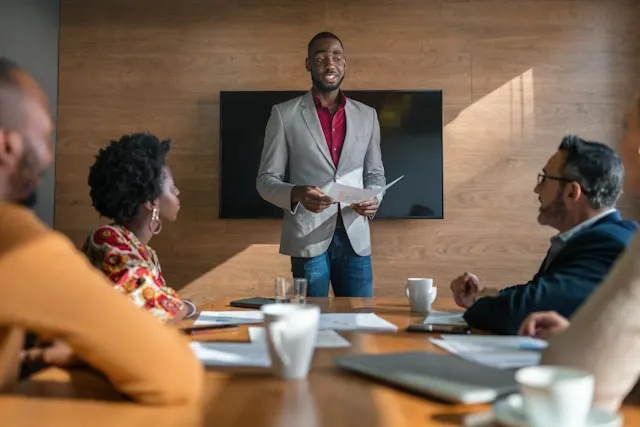How to Run a Kickoff Meeting (+5 Best Practices & Templates)

Beginnings matter a lot, especially in the world of projects. A well-crafted beginning can set the stage for success, while a poorly planned one can lead to confusion and delays. That’s why a kickoff meeting, the launchpad where the project is officially initiated, is crucial. Effective kickoff meetings bring stakeholders on the same page and fuel motivation for the journey ahead.
In this blog, we will share a step-by-step guide on how to plan, organize and run a rewarding kickoff meeting. We will also list 5 best practices to maximize meeting effectiveness, and suggest practical templates you can use for preparation and execution.
Let’s dig in.
What is a kickoff meeting?
A kickoff meeting is the initial gathering that marks the official start of a new project. It signifies the transition from the planning stages into the project’s actual execution. The term “kickoff” is derived from the action of launching or initiating something, symbolizing setting the project in motion.

The primary purpose of a kickoff meeting is to make sure that everyone involved understands the:
Kickoff meetings are typically conducted with a prepared agenda. During the meeting, the project manager or team lead outlines the project goals and expectations. Team members can ask questions and discuss potential challenges to clarify ambiguities. Kickoff meetings also often include introductions, team building activities, and discussions about communication channels and reporting procedures.
Key Benefits of a Kickoff Meeting
The kickoff meeting is the pivotal moment in the world of project management. If it’s well-executed, it can have a profound impact on the overall success of the project, and bring additional benefits.
4 Types of Kickoff Meetings
Kickoff meetings come in different forms, and the type of meeting you choose heavily depends on your project’s goals and who needs to be involved. Let’s take a look at 4 common types of kickoff meetings, emphasizing each one’s purpose, participants and significance.
Internal Kickoff Meeting
Purpose: Align the internal project team, assign roles and responsibilities, establish timelines.
Participants: Project manager, core project team members, department heads (if relevant).
Why it matters: Ensures everyone is on the same page, and sets the stage for a smooth project execution.
Example: Website redesign project.
External Kickoff Meeting
Purpose: Establishing a strong relationship with the client, clarify project goals and scope, address any initial concerns.
Participants: Project team members, client representatives.
Why it matters: Builds trust, ensures project alignment with client needs, sets a foundation for open communication throughout the project.
Example: Custom software development for a client.

Product Launch Kickoff Meeting
Purpose: Coordinate all aspects of a new product launch to ensure a smooth and successful rollout.
Participants: Cross-functional team including members from marketing, sales, product development, and customer support. Potentially executives.
Why it matters: Creates a cohesive launch strategy and maximizes the impact of the product launch.
Example: Launching a new eco-friendly home cleaning product.
Project Stakeholders Kickoff Meeting
Purpose: Inform key stakeholders about the project, gain their buy-in and support, address concerns.
Participants: Project team, key stakeholders (executives, investors, etc.)
Why it matters: Secures necessary resources and promotes a sense of shared ownership in the project’s success.
Example: Major company rebranding initiative.
How to Run an Effective Kickoff Meeting
The kickoff meeting is your opportunity to define success, energize the team, and build a solid foundation for collaboration; so use it wisely. Below is our step-by-step guide to help you conduct an effective kickoff meeting; highlighting what you can do before, during and after the meeting for outstanding results.
Before the Meeting
Define the meeting goals.
Tip: Limit goals to 2-3 major points as overly ambitious goals can overwhelm the meeting. Frame your goals as questions the meeting should answer; such as “What are the success criteria for the project?”
Choose attendees carefully.
Tip: Invite only the essential people who need to be present. Too many attendees can lead to distractions and inefficiency.
Gather the necessary items.
Tip: Have a kickoff meeting checklist of the necessary items you need to prepare for the meeting: agenda, documents, equipment, and pre-reads. Ensure that you have them ready before the meeting to avoid any last-minute scrambling.
Prepare the meeting agenda.
Tip: Send the kickoff meeting agenda and pre-reads a few days in advance so that attendees can review them and come prepared with questions or comments.
Do a test run for technological equipment.
Tip: If remote or hybrid, designate a person as “tech support” to troubleshoot any issues that may arise during the meeting. This will free you to focus on content.

During the Meeting
Record the meeting.
Tip: Always seek consent from all meeting attendees before recording. Let them know the purpose of the recording and how it will be used.
Have a warm welcome.
Tip: Start the kickoff meeting on a positive note by welcoming everyone, then state the agenda to provide context.
Engage the team with an icebreaker activity.
Tip: Keep it relevant to the project if possible. For example, have everyone share one thing they’re excited about for this project.
Share the project overview and objectives.
Tip: Provide a clear and concise overview of the project, and explain why this project matters. Visual aids (charts and graphs) will make information more digestible.
Go through the project plan.
Tip: Highlight project deliverables, key milestones and timelines. Outline the project's scope, what’s included and excluded, to prevent scope creep in the future. Ensure everyone understands the critical components and deadlines of the project.
Decide who will do what by when.
Tip: Assign specific tasks and responsibilities to team members along with due dates. Use a collaborative tool (like a project management software) to record these action items and deadlines, which will make follow-up much easier later on.
Hold a brief risk identification session.
Tip: Start at a high level. Don’t get bogged down in every potential issue, but limit to 3-5 major risk categories like resource shortage or dependency delays. Pave the way for broader risk mitigation discussions in a separate meeting.
End the meeting with a Q&A session.
Tip: If questions run long, set aside some of them to address later. Make sure you let people know their questions are important, and answers will be provided.

After the Meeting
Send the meeting notes and transcript.
Tip: You can use Maestra’s AI meeting transcription software to convert your meeting recording to text within seconds. Maestra has a very high accuracy rate, but you can always easily use the tool’s built-in text editor to edit and polish your transcript.
Follow up on action items.
Tip: Don’t just wait for milestones. Implement brief weekly meetings to review progress and address small hiccups early.
Get feedback from the participants.
Tip: A quick anonymous survey is an easy way to understand what went well and areas for improvement in the next kickoff meeting.
Regularly check-in with stakeholders.
Tip: Instead of waiting for formal updates, build in touchpoints where stakeholders can ask questions and be updated.
Best Practices for a Successful Kickoff Meeting
Besides the steps mentioned above, you can follow some key best practices to guarantee your kickoff meeting is productive and sets the stage for project success.
Choose the Right Tools
Clear and consistent communication is vital for effective projects. Select a communication tool that suits your needs and team dynamics. Also decide on a project management tool for tracking tasks, sharing files and centralizing all project information. Having this infrastructure upfront will prevent confusion and streamline collaboration, ultimately enhancing project outcomes.
Establish Rules and Roles
Outline expectations for participation etiquette, communication and decision-making. It's also wise to assign meeting roles. A facilitator (hint: you) can guide the meeting, making sure the agenda is followed and participation is balanced. A timekeeper can track speaking time and alert the facilitator when discussions are running long. Meanwhile, a notetaker can record key decisions, action items and next steps for future reference.

Don’t Get Sidetracked
Avoid information overload, as a kickoff meeting should provide a high-level overview of the project. Lengthy discussions can lead to participants zoning out or getting sidetracked. Instead, stick to key objectives, milestones and workflows. Leave the granular task breakdowns for future meetings.
Visualize the Project
People process information better when it’s presented visually. A project charter will outline the project objectives, scope and responsibilities. On the other hand, a timeline can highlight milestones, dependencies between tasks and the overall duration. Feel free to use colors and formatting strategically to emphasize main aspects of the project.

Hear from Diverse Voices
A successful kickoff meeting welcomes input from all stakeholders. To minimize the pressure, allow people time to reflect on a prompt/question, pair up to discuss their thoughts, and share with the larger group. Ask open-ended questions and actively solicit different viewpoints to promote an inclusive atmosphere with diverse perspectives.
5 Practical Kickoff Meeting Templates
Before we wrap up this blog with Frequently Asked Questions, we want to share 5 useful kickoff meeting templates you can use to clarify objectives, identify potential risks and increase efficiency. A structured template will also demonstrate professionalism and preparedness, setting a positive tone for collaboration whether your meeting is internal or external.
Notion
From a stakeholder kickoff template to partnership launch playbook, Notion offers a variety of free project kickoff templates. Choose the one that best fits your needs and team. Our favorite is the “Risk Register” template, which can help you resolve risks before they become complex problems.
Asana
Asana’s free kickoff meeting template is your go-to tool if you want to plan the occasion in advance in the best way possible. Picture your ideal meeting and adjust the template accordingly with sections like admin tasks, agenda items and meeting roles. The template also offers integrated features such as custom fields, list view and start dates.
Miro
Think of Miro’s project kickoff meeting template as your project manifesto. It involves 7 steps to run the meeting successfully: introduction, icebreaker activity, goals and topics, project RACI, questions and answers, project planning board, summary of action items with next steps. The fourth step (Roles, Accountable, Consulted, Informed) is essentially important as it defines who is responsible for what and how.

Fellow
Fellow’s project kickoff meeting agenda template outlines the process simply without missing any crucial steps. The “Scope” part will help you clarify expectations that need to be met by the end of the project. Meanwhile, with the “Timeline” part, you can build a comprehensive roadmap from project kickoff to completion.
Mural
Mural’s project kickoff template can get the whole team on the same page from the beginning. Seamlessly integrating with Zoom and Microsoft Teams, it is great for sharing ideas (your hopes and fears about the project) and transforming them into structured plans. The template can be easily organized thanks to Mural’s sticky notes and text boxes.
Frequently Asked Questions
How long is a kickoff meeting?
Most project kickoff meetings typically last 1 to 2 hours. However, very simple projects can get away with a shorter meeting ranging from 30 minutes to 1 hour. Meanwhile, a large scale, complex project may require a longer kickoff meeting, extending to a half-day or even a full-day.
What is a kickoff deck?
A kickoff deck is a slide presentation used to formally launch a project with both internal teams and external clients. It provides a high-level overview of the project by outlining the project’s goals, scope, timeline, and deliverables. This prevents confusion and keeps everyone on the same page.
How do you email a kickoff meeting for a project?
For a kickoff meeting email, you can have a subject line like “[Project Name – Kickoff Meeting] – [Date]. In the body, you can include the meeting date, time and location, the meeting agenda, and request a RSVP. Send the invite with enough notice so participants can arrange their schedules.
What is a company kickoff meeting?
A company kickoff meeting focuses on the broader direction of an entire organization. It involves setting annual goals, celebrating past successes, and building alignment across teams and departments. Held annually or semi-annually, these meetings foster a strong sense of company culture and shared purpose.
Summary
This blog shared the essential steps for conducting an effective kickoff meeting and the best practices to boost the meeting’s impact. It also explained the concept of kickoff meetings by highlighting their purpose and benefits, and recommended 5 templates for preparation and execution.
Remember: clear communication, well-defined roles and a shared understanding of goals are essential for a fruitful kickoff meeting. To streamline this process, feel free to embrace technology by utilizing project management and communication tools. With the right preparation and resources, you will set your project up for success from the very start.
